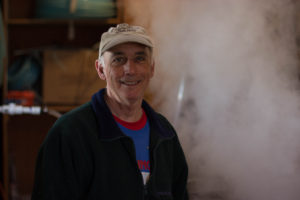Tim Kirby of the Kirby Farm, a family-run farm west of Somerset, stands in front of a maple tree adjacent to the sugar shack building used to boil tree sap into syrup. It was a typical tap day in March, and the air smelled like pancakes and French toast.
Kirby is the proprietor of the Kirby Farm, one of thousands of farms across the state that process the naturally sugary breakfast staple from late January to early March. Indeed, more than 1,200 producers in 69 counties harvested an estimated 115,000 gallons in 2015, says State Statistician Cheryl Turner of the United States Department of Agriculture Ohio Field Office. That is actually down from 2014; the brutal cold spell in February impacted production – but enough to place Ohio firmly among the top five maple producers in the country behind Wisconsin, New York and Vermont.
Tapping the sap
In a few weeks, Kirby begins the family’s winter routine for the past two decades: drilling small holes about 2 inches deep into the more than 300 maple trees the farm taps for sap. Once the holes have been drilled and flexible plastic spouts inserted to aid the flow of sap, the Kirbys connect the taps to a tubing network tens of feet in length which runs downhill to a central receptacle. During the day, sap collects around the taps and drains through the attached plastic tubes. Gravity does the rest.
Sometimes, though, gravity could use a helping hand. Kirby points out a particular tangle of tubing among the plastic web, a segment that dips between the trees to which it is bolted. Every so often, Kirby has to lift up the tubing for a few minutes to ensure the syrup travels downhill.
The next morning, barring harsh weather, there is enough sap to process. Maple trees are notoriously temperamental: prolonged cold causes the sap flows to slow and the trees to close up around the taps, while unseasonal warmth causes bloom which gives the syrup a bitter taste. Last season’s cold spell was especially hard on the Kirby’s production.
“We’re usually up to about 60 gallons of maple syrup by March, but last year we only got up to 10,” Kirby says. “All you can do is hope for milder temperatures next year.” The ideal conditions for extraction are cold nights and mild days – about 40 degrees.
But the biggest obstacle is not the weather. It is the tiny, furry creatures that scamper up and down the maple trees — “the squirrels,” Kirby says. They nibble on the plastic tubing that carries the sap downhill to the central container, causing drips. Kirby has to routinely check the lines for leaks. “It takes a lot of time,” he says.
Boiling for amber
Once the last of the 30 to 40 gallons of sap required to produce a gallon of syrup drips into the receiving tub, the processing begins. The tub is carried to the farm’s sugarhouse, a tiny wooden shack that Kirby designed and built himself with the help of his wife, children, and grandchildren. The cozy structure is furnished with a few chairs, a large wooden table, and a stove. There is also a mechanism called an evaporator that constantly boils the sap.
Once the sap is poured into the stainless steel evaporator, it is cooked by firewood to remove any excess water. The boiling process must be monitored to maintain a constant temperature – around 219 degrees Fahrenheit, Kirby says — and the syrup checked frequently for consistency. The sap is known as maple syrup once it reaches a sugar-to-liquid ratio of 67 percent.
Once the maple syrup reaches a rolling boil, it passes through a filter press. The series of fine meshes removes particles known as “sugarsand” — coagulated nutrients from the sap produced during the cooking process – from the syrup. The resulting amber-colored syrup is then heated to sterilize before it is packaged into bottles for sale.
The syrup that Kirby produces is darker than most because of its higher-than-average sugar content, a characteristic Kirby owes to both the species of maple that grow on his property and the variability in temperatures. “Most people seem to prefer it to the syrup you might find in the grocery store, honestly,” he says. “It is not sickly sweet.”
A majority of the bottles will go home with visitors participating in the Maple Madness Driving Tour, an annual tour in March sponsored by the Ohio Maple Producers Association. The Kirby Farm is among the 45 producers that participate.
The United States produces around 3.4 million gallons a year, and it is a lucrative business: the average price for a gallon of maple syrup in the United States was $36.40 in 2014. Last year, producers in Ohio alone generated $5.56 million in revenue.
But for the Kirbys, it is not about the money. “It’s something we keep doing because we love doing it,” Kirby says. “There’s something indescribably magical about watching something so natural, sap from a tree, become this amazingly delicious topping for ice cream, French toast, you name it, and we love sharing that magic with all the folks that stop by every year.”
